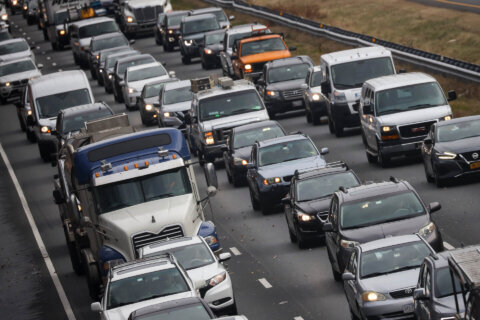This article was republished with permission from WTOP’s news partners at Maryland Matters. Sign up for Maryland Matters’ free email subscription today.
This content was republished with permission from WTOP’s news partners at Maryland Matters. Sign up for Maryland Matters’ free email subscription today.
Bowing to opponents of the plan to widen two highways that run through Montgomery County, state transportation officials announced on Wednesday that they have scaled back their footprint for the project.
The changes are reflected in a “new recommended preferred alternative” to the planned construction of toll lanes on the Capital Beltway (I-495) and Interstate 270.
Under the revision, Maryland and its team of private-sector investors would continue to move forward with the reconstruction of the American Legion Bridge and the widening of the western-most section of I-495 and the southern section of I-270.
But the new plan eliminates the construction of high-occupancy toll lanes along the 30-mile stretch of the Beltway that runs between the I-270 spurs in Bethesda and MD Route 5 in Prince George’s County.
At a news conference, Gov. Lawrence J. Hogan Jr. (R) called the bridge “the most critical” piece of his plan to ease congestion in the region.
“It’s where the biggest bottleneck is,” he said. “Our intention is moving forward.”
Planners in Montgomery and Prince George’s have long complained that the scope of the federally-mandated environmental review was overly broad given the state’s 2019 decision to build the project in phases — resulting in a needlessly-long set of issues to resolve.
Montgomery County Council President Tom Hucker (D) said the decision to drop most of the Beltway from the plan reflected the “growing public awareness of how they’ve fast-tracked this wildly unpopular project.”
To avoid having to use public funds, Hogan decided in 2017 to have private-sector companies finance and build the new “managed lanes,” in exchange for the right to set toll rates and keep almost all of the money.
Hucker said the state’s decision to drop a large piece of the original plan appeared to be an acknowledgement that President Biden and U.S. Transportation Secretary Pete Buttigieg have a vastly different philosophy than the prior administration.
The state’s approach “abjectly fails the test for transportation projects that the federal government now has — that they move people and not vehicles, and that they pass a climate test and a racial equity test,” Hucker said. “This 1970s-style project fails those 21st century standards.”
MDOT’s adoption of “new Recommended Preferred Alternative” requires the agency to issue a “supplemental” draft environmental impact statement (DEIS).
That statement will be released in “late summer,” and it will run parallel to the original, the agency said on Wednesday. The public will have the opportunity to comment on it after it is released.
MDOT and the Federal Highway Administration are still in the process of considering approximately 3,000 public comments that were submitted in response to the original draft impact statement.
“The agencies will respond to substantive comments received on both the DEIS and the (Supplemental) DEIS in the study’s combined Final Environmental Impact Statement/Record of Decision,” the agency said.
Montgomery County Executive Marc B. Elrich (D) said the state’s decision represented “a really, really important step” toward improving project.
But Elrich, who has long urged the state to abandon its insistence on establishing four HOT lanes on I-270, thinks the plan could still be scaled back further. In his view, Maryland should create two reversible lanes — carrying traffic southbound in the morning and northbound at night.
He said there is enough pavement along the highway to add one lane in each direction by rebuilding the bridges that take county roads over I-270.
“There’s nothing in planned development in Montgomery County that requires the addition to two lanes in both directions,” he said. “The growth and the concentration [of development] is going to be around Metro stations, and a little bit along the Corridor Cities Transitway.”
Hogan “has a problem that he can solve with two reversible lanes,” Elrich added. “He can solve it tomorrow.”
Rep. Anthony G. Brown (D-Md.) applauded the state for abandoning its “ill-conceived plan” to build toll lanes along the entire Maryland side of the Beltway, and he urged Hogan to ensure that transit — rail or bus-rapid transit — is incorporated in the new American Legion Bridge.
“There’s still a lot of work to be done,” he said. “The governor and his team have to be committed to working that piece as well.”
Edgar Gonzalez, head of the Suburban Maryland Transportation Alliance, said in an email that MDOT’s new plan “totally makes sense and should have been prioritized earlier, but it is great that the State and Federal agencies have agreed to separate this phase from the rest.”
“Great news for commuters, businesses and transit riders who will be able to take advantage of the HOT lanes in the future,” he added.







